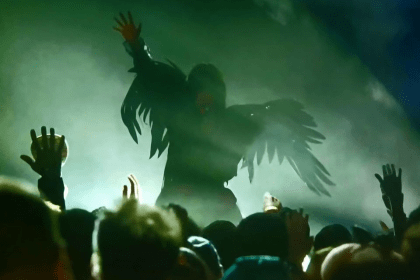A look at the anime series phenomenon
K-On! swiftly emerged as a classic anime series on its initial outing. As well as being seen to promote and encourage music, the series also managed to be great entertainment at the same time.
The title of the series is actually a contraction of the Japanese term for light music (keiongaku) and follows the adventures of a group of high school friends who form their own band. It’s a ‘slice of life’ story that can be compared to earlier anime titles such as Azumanga Daioh or Lucky Star. The central characters come from standard anime stereotypes, but it’s this simplicity that lends the series it’s charm and appeal.
K-On! began as a manga by creator Kakifly and was originally serialised as a 4-panel strip (known as a 4-koma) in magazines by manga publisher Houbunsha. A 13-part anime was commissioned by Kyoto Animation (The Melancholy of Haruhi Suzumiya, Lucky Star) and originally aired back in 2009.
The story of Ho-kago Tea Time (as the band decide to call themselves) goes through their early days of getting to grips with playing their instruments of choice and follows the development of the characters as they become more confident both in music and in life.

Ritsu Tainaka is the energetic and often self-serving drummer for Ho-kago Tea Time (she automatically declares herself Club President!) that kicks off the story. It’s Ritsu who decides to join her school’s Light Music Club, but is then shocked to discover that the club can only exist if there are at least 4 members to keep it running.
Ritsu decides to do a bit of recruiting and ‘borrows’ childhood friend Mio to join the club.

Mio Akiyama is a very shy and sensitive character, yet also manages to be the most competent and grown-up of all the band members. She plays bass (which she plays left-handed) and has some real musical experience. Mio is also the unfortunate choice for writing lyrics for Ho-kago Tea Time’s first songs.
Although the lyrics are very light and child-like, such as for the song ‘Fuwa Fuwa Time’ (which could be interpreted as ‘Light And Fluffy Time’) they have a certain charm that soon wins people over – especially when Mio is inadvertently put in the position of lead vocalist for the band’s debut performance in one of the most classic scenes from the series.

Yui Hirasawa is very much a traditional anime character – an air-headed klutz that somehow manages to remain loveable at the same time. Yui’s main problem is that she’s easily distracted – which initially proves to be a particular hurdle as she’s lead guitarist for the band.
But with some perseverance and dedication (including taking her guitar to bed with her!) Yui becomes an accomplished musician and finds her true self on stage.

Tsumugi Kotobuki is the band’s keyboard player. Known as ‘Mugi’ she comes from a rich background, but has a very sweet and charming personality. Originally intending to join the school’s choir club, Mugi is persuaded to instead join the Light Music Club.
It’s Mugi who also keeps the band stocked up on tea and cakes so that they can live up to their name of ‘Afternoon Tea Time’!

The girls are later joined by Azusa Nakano who provides second guitar for the band. Although she’s much younger than the other characters, Azusa is surprisingly serious and focussed for her age.
Initially dismissive of the band’s penchant for tea breaks and laziness, the other girls swiftly discover that Azusa has a weak spot for cakes and sweet treats and use this to break down her harsh exterior.
K-On! is also notable for the music in the series. There’s a real kick to opening theme ‘Cagayake! Girls’ – and ending theme ‘Don’t Say “Lazy”’ is pure J-Pop goodness as well.
The arc of the first series takes us through the formation of the band through to their debut performance and sets the scene for Ho-kago Tea Time to take their first steps into gigging in the outside world.
There’s a gentle quality to the stories that’s epitomised by the laid-back approach the girls take to practising (which primarily seems to consist of tea and cake…), although there’s plenty of dramas threatening to trip up the girls (sometimes quite literally!) before a live performance. Usually these dramas surround Yui, whether through failing to maintain her instrument or being bedridden with illness or generally just being Yui.
Along the way the girls are mentored by Sawako Yamanaka who teaches the girls, but was also a former member of the Light Music Class herself. Sawako is revealed to have had a true Rock N Roll personality during her student days, especially when the girls discover recordings of Sawako’s band, but she’s also desperately trying to cover this past up to maintain the illusion of a sensible, respectable member of the teaching staff.

The second series was titled K-On!! (note the second exclamation mark!) and featured twice as many episodes as the first series. The second series followed the girls through to graduation and was itself followed by a special theatrical K-On! film which focussed on the girls post-graduation trip to the UK.
The second series has yet to be released in the West as it was initially held up due to the original distributor Bandai Entertainment taking the decision to cease all anime distribution. Luckily, Sentai Filmworks recently announced that it had licensed the second series (and is also collaborating with the original dub voice actors) for a release later this year.
K-On! is remarkably simple in its construction and story-telling, but having the focus on the creation and evolution of a band is a brilliant conceit. After all, who hasn’t wanted to be in a band at one time or another?
J-Pop Go salutes K-On! and we hope that the amps for Ho-kago Tea Time go up to 11!









